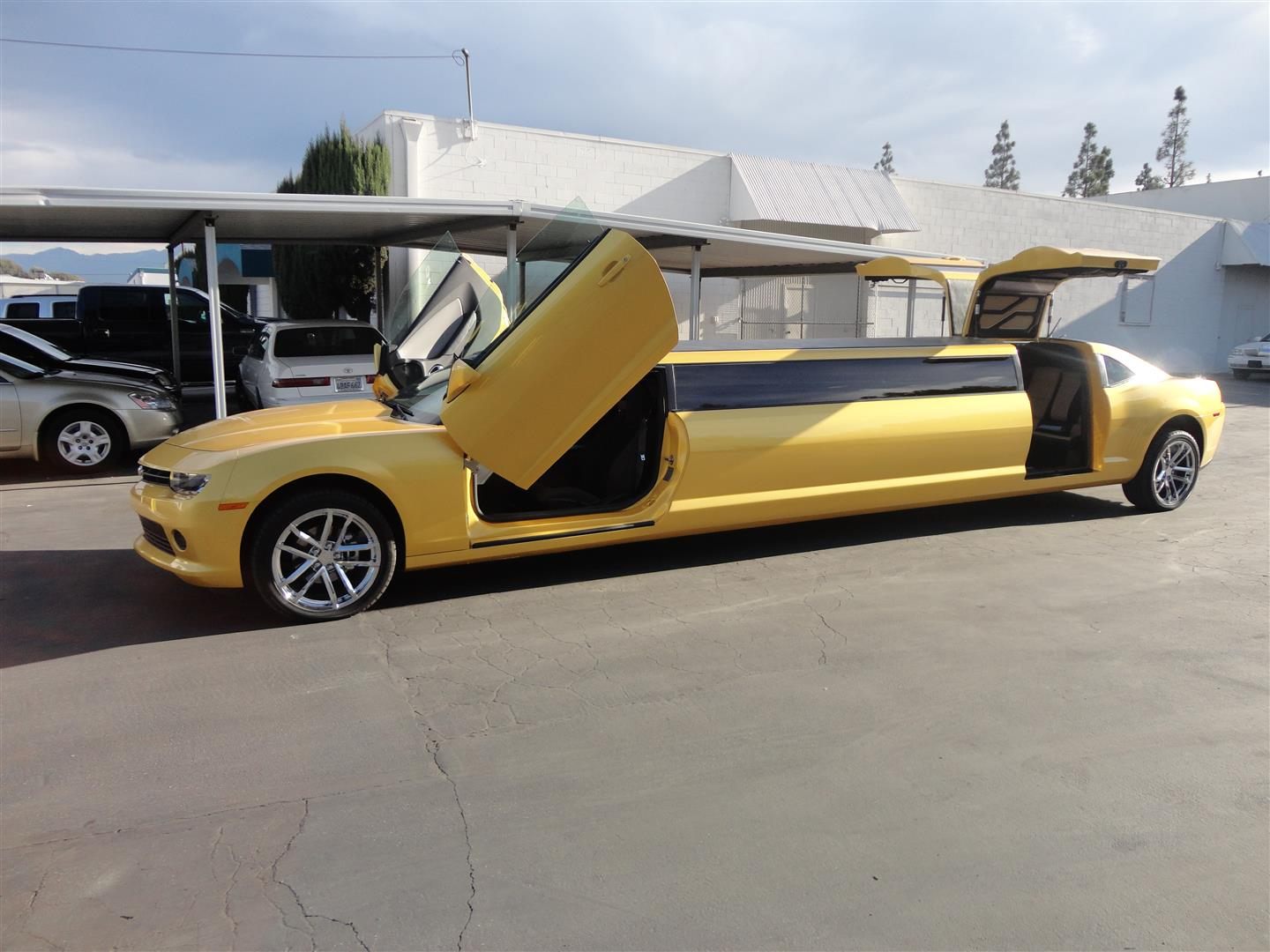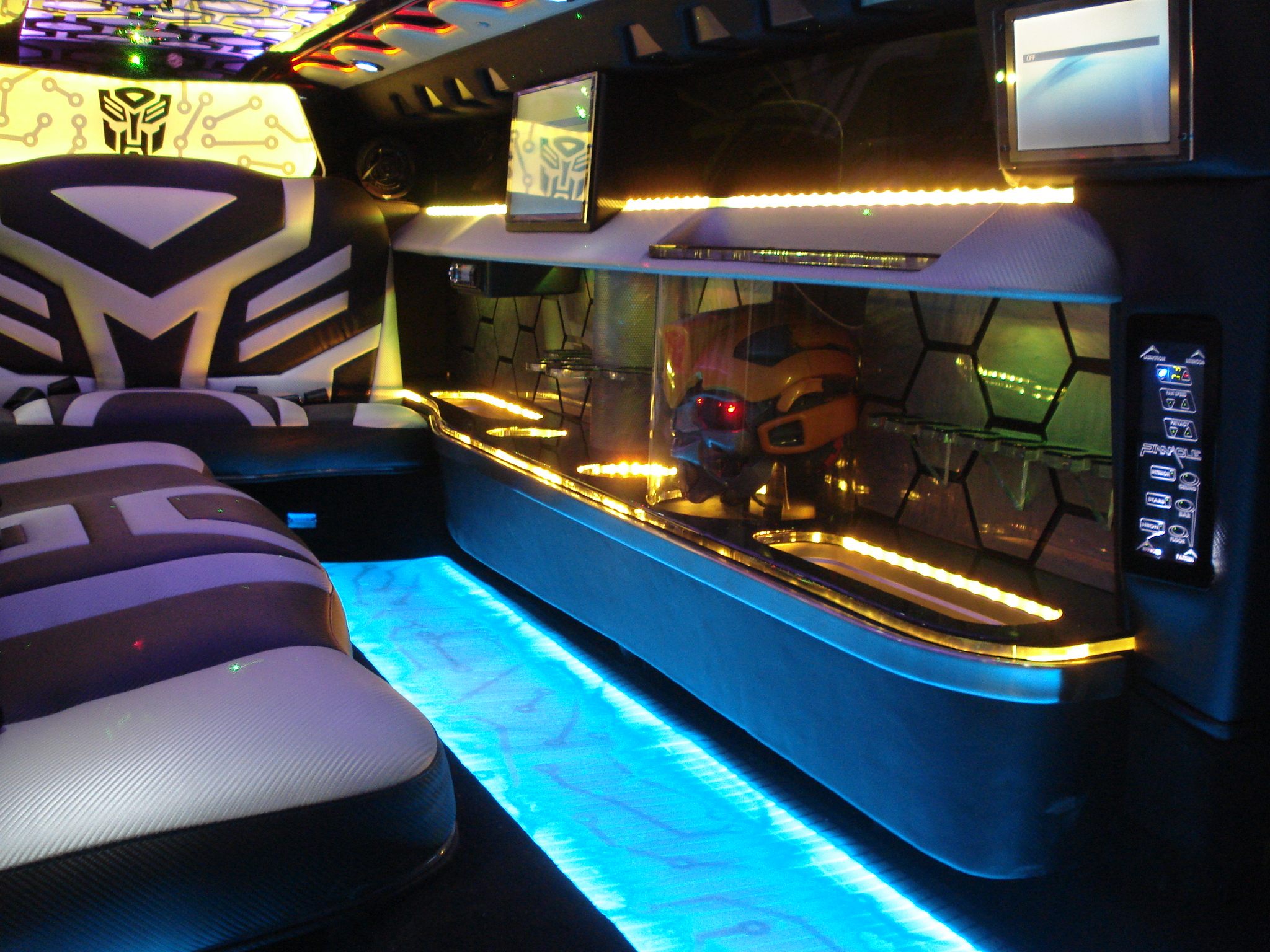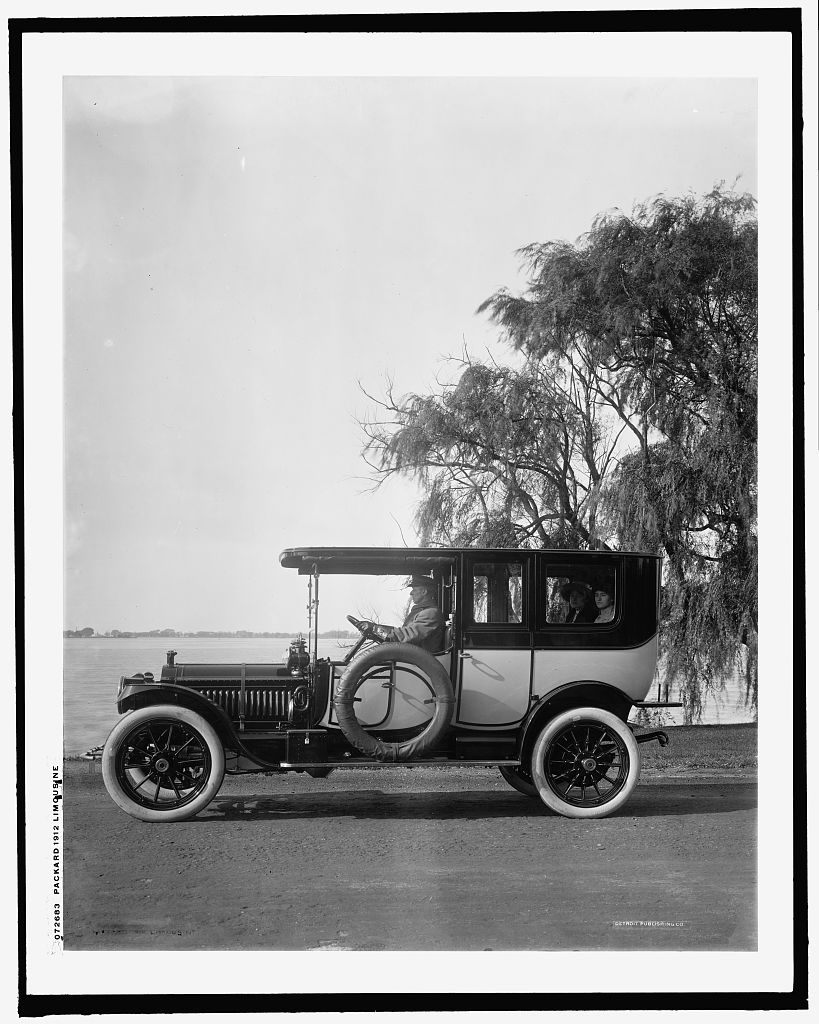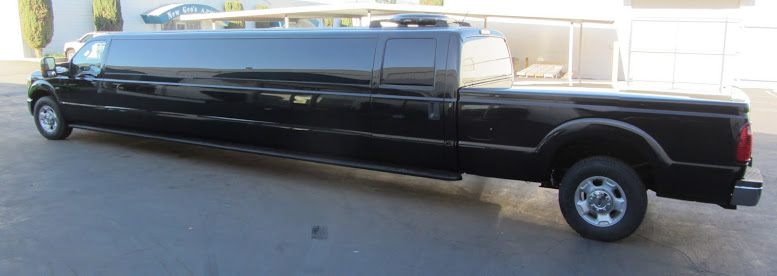Today’s Custom Limos Have Hardwood Floors and Hot Tubs

A yellow stretch Transformers Camaro - originally a two door car with an extra set of gull-wing doors. (Photo: Courtesy Pinnacle Limousines)
Most contestants on this season’s premier of The Bachelorette rolled onto the scene in run-of-the-mill limousines—the kind that routinely ferry brides and prom dates from point A to B. But 31-year-old Sean E., whose profession is listed as “Amateur Sex Coach”, arrived in a car in which the entire interior had been converted into a sloshing, drivable hot tub. The vehicle elicited cackles of delight from the show’s two bachelorettes and a less enthusiastic response from fellow contestant Ryan M., who grumped, “That car sucks!”
The car is the Carpool DeVille, a converted Cadillac billed as the “world’s first (and only!) fully functional, fully mobile hot tub.” It took seven years and a Kickstarter campaign to build. And its success is only part of a broader trend: As conventional limos have become more accessible to the masses, custom vehicles become more and more elaborate.
It’s not just hot tubs. It’s Batcars built for 20, touch-screen modifications, limos with hardwood floors and stripper poles.
According to “Stretching It: The Story of the Limousine”, published by the Society of Automotive Engineers, limos originated in the early 1900s. The first cars were simple covered coaches with drivers. (A driver, or “chauffeur”, is an integral part of the glamorous appeal of a limousine.) “The words ‘limousine’ and ‘chauffeur’ have roots in the pre-1900 days of carriages and trains when professional drivers and ‘stokers’ were required to manage horses and steam engines,” write authors Michael L. Bromley and Tom Mazza. “In the region of the Limousin, France, shepherds long ago developed a unique, oversized and hooded garment called a ‘limousine’ for protection from the rain and cold.” Limousines quickly became associated with wealth and status as aristocrats, film stars and presidents emerged from their doors. Entrepreneurs eventually saw the value in expanding the cars’ accessibility. In 1978 there were less than 1,500 limousine operators in the United States. That number shot up to nearly 10,000 by 1999. According to the 2014-2015 industry guide published by Limousine, Charter & Tour magazine, there are 11,420 operators today and 115,600 vehicles in service, contributing to an industry worth $2.92 billion.
 The interior of the Transformer Camaro. (Photo: Courtesy Pinnacle Limousines)
The interior of the Transformer Camaro. (Photo: Courtesy Pinnacle Limousines)
“We make our limos custom for the actual user,” says Figueroa. “So if they say they need eight passengers we make it eight, if they say they need ten, we make it ten. They say they need a lot of lighting they get a lot of lighting.”
Figueroa has been building custom limos for 15 years. Many car manufacturers build standard limousines that can be driven directly off the lot, but Figueroa is part of a specialty industry that cuts apart, stretches, and customizes cars to order. His customers are typically companies that rent the vehicles out, but he estimates five percent are private owners. Buyers purchase the car and then pay Figueroa between $40,000-$50,000 to trick them out, although they can get quite a bit more expensive. Figueroa says his most expensive customization cost the buyer around $100,000. His company has sold limos in over 20 countries and completes about one per week.

A Packard limo from 1912. (Photo: Library of Congress)
With a series of heavy-duty saws, Figueroa and his team cut already massive cars (think Hummers and buses) in half. A really tough car can easily destroy a few saw blades, so for those they use a high-powered plasma torch. Once the car is halved, they add in additional doors, seating and even axles and wheels. And, most importantly, they build in all the things that make an average rider feel like Britney Spears.
Extra seating is a given—that’s the whole point. It’s not usual for Figueroa to build a car that holds up to 30 people. Television screens, light-up “disco floors” and wet bars are de rigueur. Some limos even get hardwood floors. Carpeting is also possible, but not as popular. Laser and strobe lights are often requested. Figueroa says one of the most commonly demanded features these days are touch screen controls. This century’s luxury vehicle is a little less hot tub, a bit more iPhone.

Adding extra wheels and axels are often a structural necessity. (Photo: Courtesy Pinnacle Limousines)
But that’s not to say Figueroa hasn’t built his share of crazy cars. He built a pink stretch Hummer. He built a Batman-themed car complete with a Batcave, a Batman bust, and bat likenesses strewn throughout the interior. He built a bright yellow stretch Camaro with a Transformers theme and a Terminator limo with skulls embedded in the floor.

Holy Batcave! Passengers in the Bat-limo get the full Bruce Wayne experience. (Photo: Courtesy Pinnacle Limousines)
 This Batman-themed limo sold to a customer in Australia had the superhero’s insignia throughout the car. (Photo: Courtesy Pinnacle Limousines)
This Batman-themed limo sold to a customer in Australia had the superhero’s insignia throughout the car. (Photo: Courtesy Pinnacle Limousines)
 Hollywood themes are popular. In addition to the spooky bust, this Terminator-themed vehicle included skulls embedded in the floor and a replica of the futuristic rifle from the movie. (Photo: Courtesy Pinnacle Limousines)
Hollywood themes are popular. In addition to the spooky bust, this Terminator-themed vehicle included skulls embedded in the floor and a replica of the futuristic rifle from the movie. (Photo: Courtesy Pinnacle Limousines)
And he has built hot tub limos. Specifically, escalades with external pickup bed hot tubs. But they aren’t quite like the Carpool De Ville.
“It’s a gimmick,” says Figueroa. “So basically the car is parked, it’s not like you can drive around town with it, it would splash everywhere. They’re for promotional events. You drive somewhere, you fill it up, you get people in there for a little while and then they drain it and take off again. It’s basically to say you got a hot tub in there.”
There are some vehicles that Figueroa won’t even take on—such as vehicles that require mods adding thousands of pounds over what is practical for an engine to pull. Five to six thousand additional pounds are doable; 10,000 pounds are not.
Figueroa’s job means that he’s one of the few who isn’t dazzled by cruising in excess.
“It’s pretty much every day for me,” says Figueroa of the limo life. ”It’s not that big of a deal anymore.”



Follow us on Twitter to get the latest on the world's hidden wonders.
Like us on Facebook to get the latest on the world's hidden wonders.
Follow us on Twitter Like us on Facebook